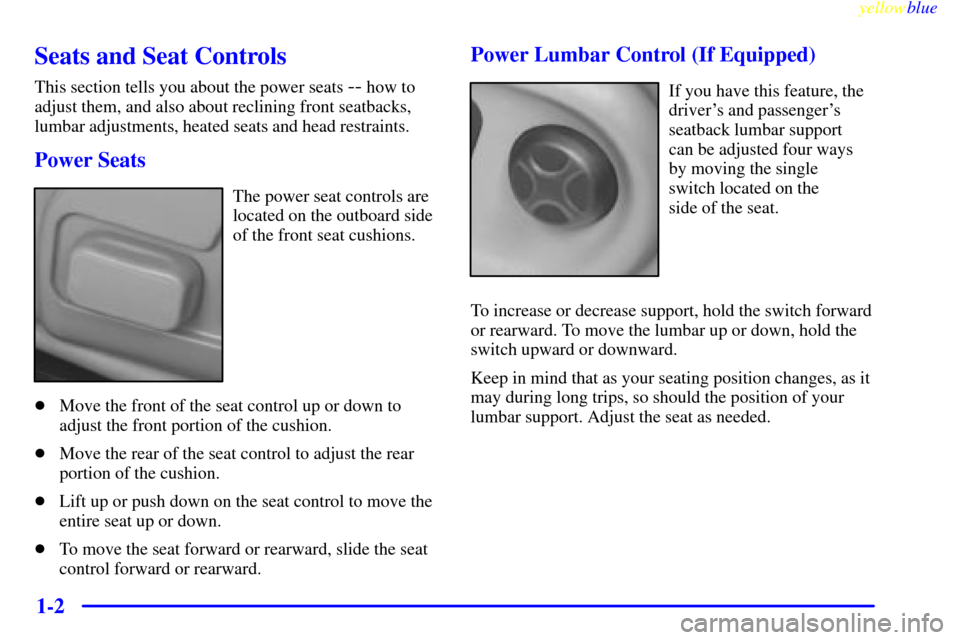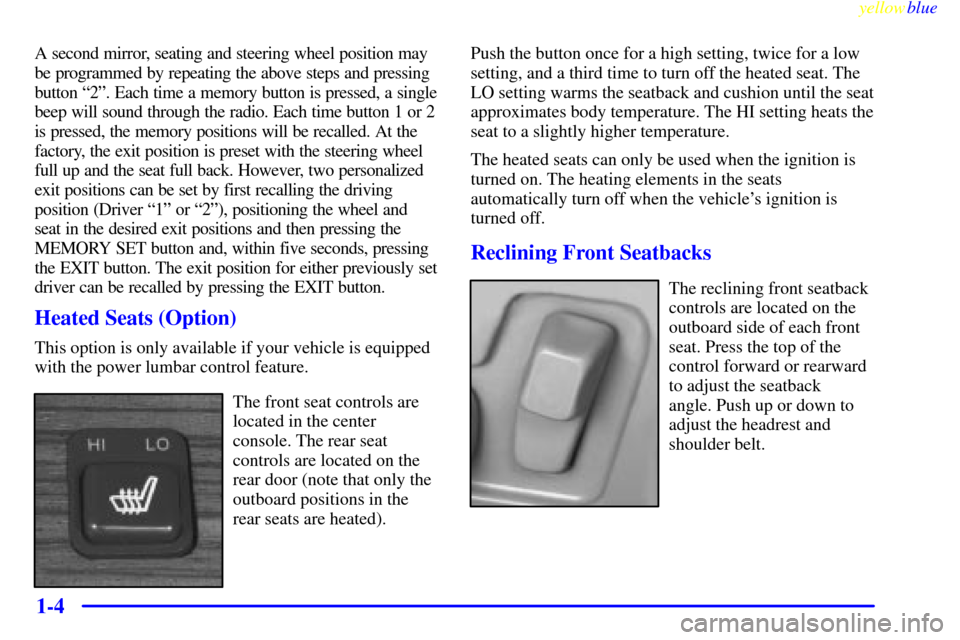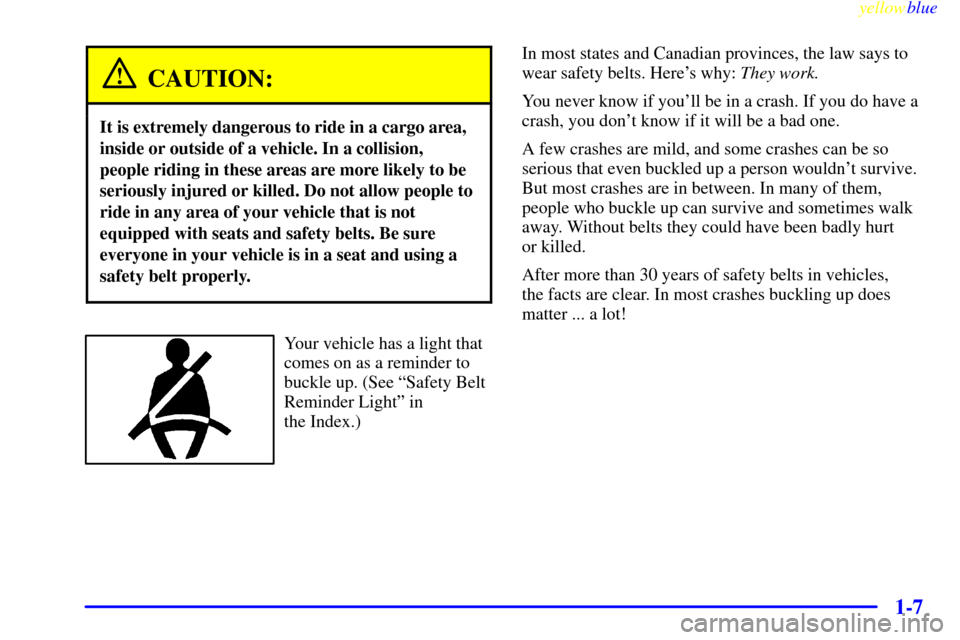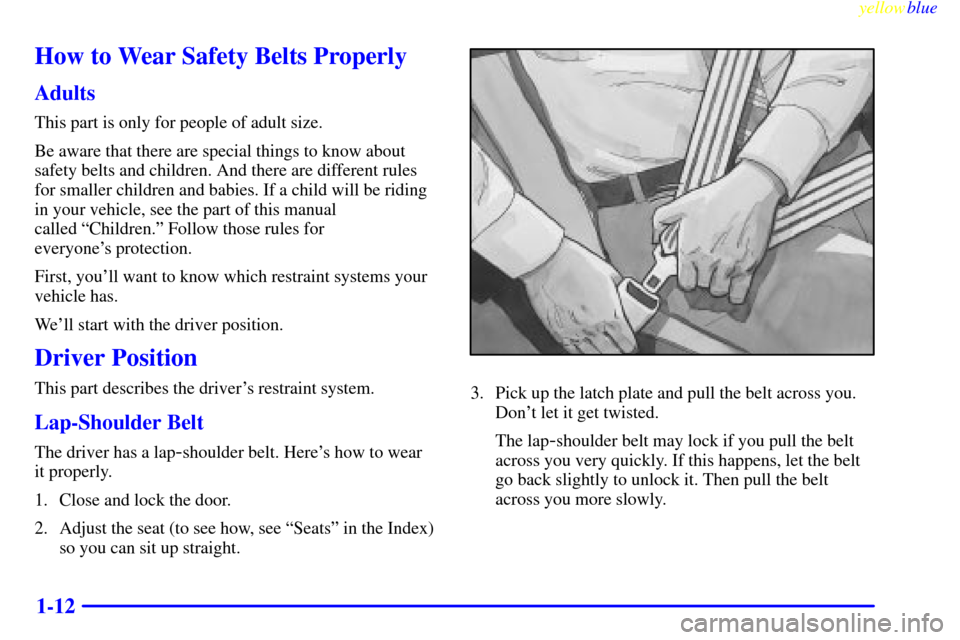Page 1 of 362

yellowblue
i
The 1999 Cadillac Seville Owner's Manual
1-1 Seats and Restraint SystemsThis section tells you how to use your seats and safety belts properly. It also explains the ªSIRº system.
2-1 Features and ControlsThis section explains how to start and operate your vehicle.
3-1 Comfort Controls and Audio SystemsThis section tells you how to adjust the ventilation and comfort controls and how to operate your audio system.
4-1 Your Driving and the RoadHere you'll find helpful information and tips about the road and how to drive under different conditions.
5-1 Problems on the RoadThis section tells you what to do if you have a problem while driving, such as a flat tire or overheated engine, etc.
6-1 Service and Appearance CareHere the manual tells you how to keep your vehicle running properly and looking good.
7-1 Customer Assistance InformationThis section tells you how to contact Cadillac for assistance and how to get service and owner publications.
It also gives you information on ªReporting Safety Defectsº on page 7-10.
8-1 IndexHere's an alphabetical listing of almost every subject in this manual. You can use it to quickly find
something you want to read.
Page 7 of 362
1-
yellowblue
1-1
Section 1 Seats and Restraint System
Here you'll find information about the seats in your vehicle and how to use your safety belts properly. You can also
learn about some things you should not do with air bags and safety belts.
1
-2 Seats and Seat Controls
1
-6 Safety Belts: They're For Everyone
1
-11 Here are Questions Many People Ask About
Safety Belts
-- and the Answers
1
-12 How to Wear Safety Belts Properly
1
-12 Driver Position
1
-18 Safety Belt Use During Pregnancy
1
-19 Right Front Passenger Position
1
-19 Supplemental Inflatable Restraint
(SIR) Systems1
-27 Rear Seat Passengers
1
-30 Children
1
-33 Child Restraints
1
-43 Larger Children
1
-46 Safety Belt Extender
1
-46 Checking Your Restraint Systems
1
-46 Replacing Restraint System Parts
After a Crash
Page 8 of 362

yellowblue
1-2
Seats and Seat Controls
This section tells you about the power seats -- how to
adjust them, and also about reclining front seatbacks,
lumbar adjustments, heated seats and head restraints.
Power Seats
The power seat controls are
located on the outboard side
of the front seat cushions.
�Move the front of the seat control up or down to
adjust the front portion of the cushion.
�Move the rear of the seat control to adjust the rear
portion of the cushion.
�Lift up or push down on the seat control to move the
entire seat up or down.
�To move the seat forward or rearward, slide the seat
control forward or rearward.
Power Lumbar Control (If Equipped)
If you have this feature, the
driver's and passenger's
seatback lumbar support
can be adjusted four ways
by moving the single
switch located on the
side of the seat.
To increase or decrease support, hold the switch forward
or rearward. To move the lumbar up or down, hold the
switch upward or downward.
Keep in mind that as your seating position changes, as it
may during long trips, so should the position of your
lumbar support. Adjust the seat as needed.
Page 10 of 362

yellowblue
1-4
A second mirror, seating and steering wheel position may
be programmed by repeating the above steps and pressing
button ª2º. Each time a memory button is pressed, a single
beep will sound through the radio. Each time button 1 or 2
is pressed, the memory positions will be recalled. At the
factory, the exit position is preset with the steering wheel
full up and the seat full back. However, two personalized
exit positions can be set by first recalling the driving
position (Driver ª1º or ª2º), positioning the wheel and
seat in the desired exit positions and then pressing the
MEMORY SET button and, within five seconds, pressing
the EXIT button. The exit position for either previously set
driver can be recalled by pressing the EXIT button.
Heated Seats (Option)
This option is only available if your vehicle is equipped
with the power lumbar control feature.
The front seat controls are
located in the center
console. The rear seat
controls are located on the
rear door (note that only the
outboard positions in the
rear seats are heated).Push the button once for a high setting, twice for a low
setting, and a third time to turn off the heated seat. The
LO setting warms the seatback and cushion until the seat
approximates body temperature. The HI setting heats the
seat to a slightly higher temperature.
The heated seats can only be used when the ignition is
turned on. The heating elements in the seats
automatically turn off when the vehicle's ignition is
turned off.
Reclining Front Seatbacks
The reclining front seatback
controls are located on the
outboard side of each front
seat. Press the top of the
control forward or rearward
to adjust the seatback
angle. Push up or down to
adjust the headrest and
shoulder belt.
Page 13 of 362

yellowblue
1-7
CAUTION:
It is extremely dangerous to ride in a cargo area,
inside or outside of a vehicle. In a collision,
people riding in these areas are more likely to be
seriously injured or killed. Do not allow people to
ride in any area of your vehicle that is not
equipped with seats and safety belts. Be sure
everyone in your vehicle is in a seat and using a
safety belt properly.
Your vehicle has a light that
comes on as a reminder to
buckle up. (See ªSafety Belt
Reminder Lightº in
the Index.)In most states and Canadian provinces, the law says to
wear safety belts. Here's why: They work.
You never know if you'll be in a crash. If you do have a
crash, you don't know if it will be a bad one.
A few crashes are mild, and some crashes can be so
serious that even buckled up a person wouldn't survive.
But most crashes are in between. In many of them,
people who buckle up can survive and sometimes walk
away. Without belts they could have been badly hurt
or killed.
After more than 30 years of safety belts in vehicles,
the facts are clear. In most crashes buckling up does
matter ... a lot!
Page 18 of 362

yellowblue
1-12
How to Wear Safety Belts Properly
Adults
This part is only for people of adult size.
Be aware that there are special things to know about
safety belts and children. And there are different rules
for smaller children and babies. If a child will be riding
in your vehicle, see the part of this manual
called ªChildren.º Follow those rules for
everyone's protection.
First, you'll want to know which restraint systems your
vehicle has.
We'll start with the driver position.
Driver Position
This part describes the driver's restraint system.
Lap-Shoulder Belt
The driver has a lap-shoulder belt. Here's how to wear
it properly.
1. Close and lock the door.
2. Adjust the seat (to see how, see ªSeatsº in the Index)
so you can sit up straight.
3. Pick up the latch plate and pull the belt across you.
Don't let it get twisted.
The lap
-shoulder belt may lock if you pull the belt
across you very quickly. If this happens, let the belt
go back slightly to unlock it. Then pull the belt
across you more slowly.
Page 40 of 362
yellowblue
1-34
A rear-facing infant restraint (B) positions an infant
to face the rear of the vehicle. Rear
-facing infant
restraints are designed for infants of up to about
20 lbs. (9 kg) and about one year of age. This type
of restraint faces the rear so that the infant's head,
neck and body can have the support they need in a
frontal crash. Some infant seats come in two
parts
-- the base stays secured in the vehicle and
the seat part is removable.
Page 42 of 362
yellowblue
1-36
A booster seat (F, G) is designed for children who are
about 40 to 60 lbs., or even up to 80 lbs. (18 to 27 kg, or
even up to 36 kg), and about four to eight years of age.
A booster seat is designed to improve the fit of the
vehicle's safety belt system. Booster seats with shields
use lap
-only belts; however, booster seats without
shields use lap
-shoulder belts. Booster seats can also
help a child to see out the window.